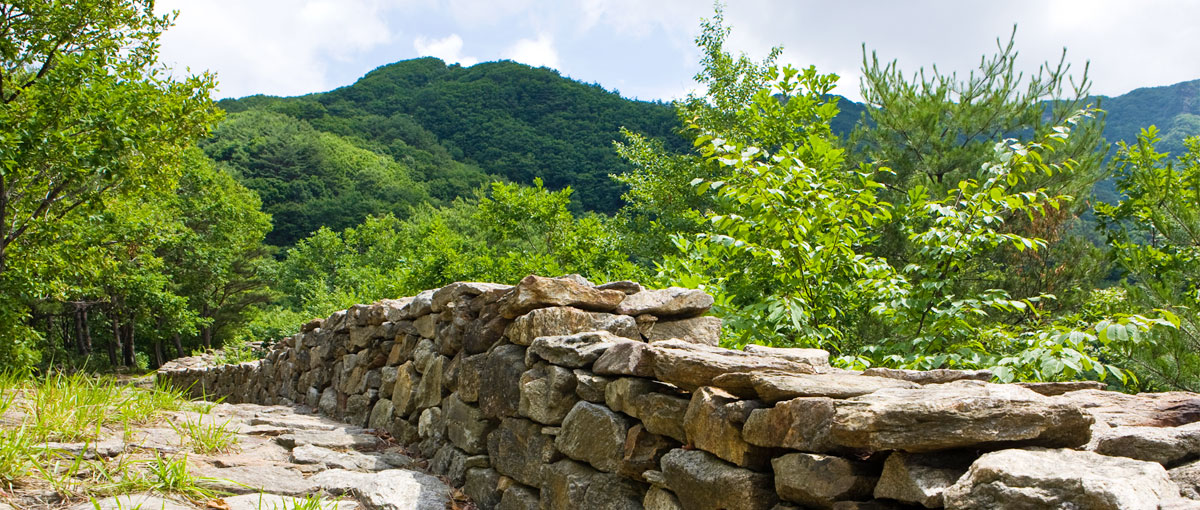Yeongwonsanseong Fortress in Wonju (Historic Site No. 447)

(Historic site no.447)
eongwonsanseong Fortress in Wonju
Detail
- Classification : Structure/ politics and security/ fortress/ ramparts
- Unit/ extent : 175537㎡
- Designation/ registration date : June 2, 2003
- Location : San 50-2, Geumdae-ri, Panbu-myeon, Wonju-si, Gangwon-do (and the other 1 lot)
- Period : Silla era
- Manager (management group) : Wonju City
Yeongwonsanseong Fortress is a fortress built with stones along the ridge of Chiaksan Mountain (1,288 meters above sea level) in Wonju.
Though it is not exactly known when the fortress was constructed, it has been considered a relic related to Yang Gil from Bugwon and Gung Ye who were the strongest local powers during the late Silla era. The fortress is also the place where General Won Chung-gap defeated the rebels from Yuan China leading the local defense forces in 1291 (17th year of King Chungryeol of Goryeo). During the Japanese Invasion in 1592 in the Joseon era, the fortress once turned into a scene of tragedy where the numerous soldiers and residents fought to the end under the command of County Magistrate Kim Je-gap and were killed when the fortress was occupied by the Japanese Army. Later, the fortress functioned as a military encampment on the upstream of the Hangang River for a certain period of time until it was abandoned.
From a top view, the fortress is in the shape of an irregular oval close to a triangle, and the total length of the fortress wall amounts to about 2.4 kilometers. The fortress wall still preserves a relatively high number of stones that were roughly cut and piled up in rows to form the wall. The fortress has a tail-shaped yongdo (passageway) that connects its northeast corner to a higher mountain peak. The yongdo is not only useful in communicating with other regions, bus also in observing and attacking enemies approaching through the mountain ridge from the Namdaeryeong Pass. On the other hand, the fortress is equipped with gokseong (curved parts of the fortress wall) at the points where the fortress wall is bent along the mountain ridge to defend the fortress against the enemy approaching through the ridge. Currently, the gokseong remains at four points each on the southeast, north and west walls, respectively.
An ancient source describes the fortress as follows: "Yeongwonsanseong Fortress is a stone fortress with a circumference of about 1,250 meters, and there was a well and five springs within the fortress, which are now blocked." Today, sewers to drain water and the sites of the south, north, and west gates remain inside the fortress. In addition, chiseong (square turrets protruding beyond the fortress wall) are found on the east side of the north gate to strengthen defensive power. Other various building sites have been identified in several places inside the fortress, along with three charcoal kilns. The artifacts excavated from the fortress include ceramics and roof tiles used in the Goryeo and Joseon eras, but they are not diverse in types and small in quantity.
The most outstanding characteristic of this fortress is that while its cheseong (main fortress structure) and yeojang (battlements) are clearly distinguished, they are indistinguishable when viewed from the outer wall and that there are no openings for shooting in the yeojang. In addition, in terms of the construction method, it is emblematic of Korean mountain fortresses. All the features of fortress―its location, the functions of its facilities, its yeojang, and the structure of its chiseong and gates―exemplify the characteristics of Goryeo's mountain fortresses. The most outstanding characteristic of this fortress is that while its cheseong (main fortress structure) and yeojang (battlements) are clearly distinguished, they are indistinguishable when viewed from the outer wall and that there are no openings for shooting in the yeojang. In addition, in terms of the construction method, it is emblematic of Korean mountain fortresses. All the features of fortress―its location, the functions of its facilities, its yeojang, and the structure of its chiseong and gates―exemplify the characteristics of Goryeo's mountain fortresses.